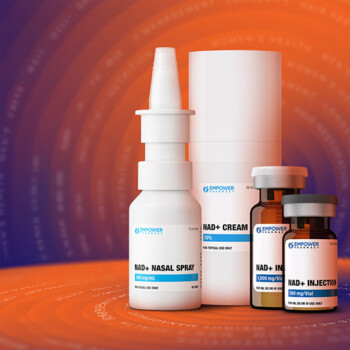Article Summary
Considerations for IV therapy: facility, staff, processes, supplies, and patient safety are vital. Key steps include finding the right vendor, staff training, scheduling, preparation, patient consultation, and emergency planning.There are many factors to consider when planning to open an IV therapy clinic or add IV therapy services to an existing practice. Providers will need to ensure that you have the proper facility, staff, processes and supplies. Though not an exhaustive list, below are some of the things you should think about as you plan to offer this service to patients.
Finding the Right Vendor for IV Therapy Nutrients
Identify an FDA-registered 503B outsourcing facility that offers all the compounded or commercial nutrients you need to practice. Ideally, the facility will offer preservative-free options. It will also need to be licensed to ship medications to your state. 503B (office-use) products can be ordered in bulk at a wholesale price without a patient-specific prescription.
Basic Needs of an IV Therapy Practice
- Patient room: A single designated IV space with two to 10 chairs is common, depending on the expected number of patients. Some clinics that have multiple examination or procedure rooms spread out IV chairs so there is more than one option in case one room is in use
- Prep room: A designated prep area used to store IV/injectable medications and supplies along with a work area where bags can be prepared and documented
- IV-trained nurse(s), practitioners and support staff
- IV apparatus
- IV components: Saline bags, tubing, catheter, swabs, etc.
- Emergency supplies located in the patient room within reach (more information below)
- Refrigerator: This should be dedicated for medication storage only and can be stored in the prep room if there is space
- Closed dark-storage cabinets for light-sensitive solutions
- TV/music: Recommend to loop a PowerPoint and/or video discussing IV treatments and other services offered at the clinic
- Comfortable reclining chairs
- Wheeled supply cart
- IV poles, ceiling chain or wall hooks to suspend the IV drips
- Rolling stool or chair for administering staff
- Oxygen tank with masks and nasal cannula
- Laryngoscope with multiple sizes of endotracheal tubes
- Stethoscope, blood pressure monitor, thermometer, pulse oximeter
- Reading material with information pertaining to IV treatments
- Wi-Fi
- Food: Bananas, granola bars, etc.
- Bottled water
- Heating pad
- Cold packs
It is important to refer to your state’s regulations to confirm any additional requirements needed to prepare and administer IV therapies.
Staff Considerations
Intravenous infusions are often performed at the clinic, but sometimes they are administered to the patient in a home or mobile setting. Supplies, risks and protocols might change depending on the setting. Be sure staff are trained and equipped to administer IVs in the specific setting. They should never leave the patient unattended during the infusion.
Each IV should be performed in a comfortable setting and started by a licensed practitioner who has the authority to administer IV treatments and perform the venipuncture. Supportive staff can perform ancillary tasks and observe the patient during the treatment. Support staff may include licensed vocational nurses (LVNs), licensed practical nurses (LPNs), and certain medical assistants and IV technicians, depending on medical board guidelines.
The clinic’s IV team should be trained in product compatibility and avoid combining products that will become unstable due to incompatibility with other ingredients. Compounding pharmacies and outsourcing facilities that specialize in IV nutrition usually offer clinical support. Be sure to consult the vendor who supplied the ingredients to learn more about product compatibility and stability.
Scheduling IV Therapy Patients
Create a system that accommodates the ability to schedule patients for future IV appointments and be prepared for unscheduled “walk-in” patients. The ability to accommodate walk-ins efficiently is important since many of the conditions treated with IV therapies and popular cocktails result in immediate demand for on-the-spot treatment. The clinic should be prepared to administer any advertised cocktail on demand with minimal waiting time.
Pre-scheduled patients can be confirmed prior to their appointment with some preparation on the day of their appointment to make the process efficient. This includes identifying the supplies and ingredients needed to complete the appointment to making sure everything is on hand. However, do not prepare the IV bag itself until the patient arrives and is ready to be infused.
IV Day Preparation
At the beginning of each day, check the schedule and confirm there is enough fresh product and supplies available to cover the patients. “Fresh” in this sense means each product used in the IV treatment is within its beyond-use date (BUD) or expiration date. Do not store room-temperature medications in the refrigerator or freezer. Conversely, do not store refrigerated medications at room temperature. Light-sensitive IVs should be covered in tinfoil or other opaque material. Consult your product vendors to learn which products become unstable when exposed to light.
IV bags and push syringes should only be prepared by aseptically trained medical staff under the supervision of the medical director and in accordance with state and federal regulations. Supplies can be prepared and organized ahead of time so that they are ready for the ingredients to be added when the patient arrives. However, IV bags must be mixed at the time of administration. Once the IV bag containing the base solution has been punctured and ingredients added, it should be administered immediately. Prepared IV bags and syringes are not meant for storage and are immediate-use preparations. Additional ingredients can be added during the infusion once the line is set.
Basic Supplies for IV Therapy Appointment
- IV bags containing sterile water for injection, saline or Ringer’s solution
- Tourniquet
- Antiseptic
- Tegaderm™
- Extension tubing
- IV catheter
- Saline flush
Simple IV Therapy Appointment Flow
- Patient is escorted to the IV chair at the time of appointment (on time) or within 10 minutes of walk-in (not counting preparation time)
- Prepare the patient’s IV bag or syringe
- Place prepared pushes, tape, bandages and all needed supplies near the patient prior to starting
- Collect patient’s vitals and discuss current condition and symptoms
- Explain to the patient the details regarding the nutrients being administered, uses, benefits, frequency and additional therapies that might benefit the patient
- If the clinic offers hormone replacement therapy (HRT) or testosterone replacement therapy (TRT), give all new patients a hormone-deficiency-symptom questionnaire and, if appropriate, offer a blood test to evaluate overall health and hormone levels (more information below). The clinic team member who is monitoring the patient’s IV should be trained to engage with the patient and look for opportunities to retain them
- If performing blood work, try to draw blood prior to administering the IV infusion. If that is not possible, wait for 15 minutes after the IV before performing the blood draw, and be sure to use a different site than what was used for the IV venipuncture
Sample Information Recorded in Patient Chart
- Name
- Date of birth
- Each agent used in the treatment
- Lot number
- Manufacturer
- Quantity used
- Date administered
- General condition and present symptoms
- Goals
- Allergies
- Informed consent that is signed by the patient
- Vitals (taken prior to IV)
- What the patient ate prior and approximate time they ate it
- Time at the start and completion of the infusion
Sterile Injectable Log
The sterile injectable log must be kept in the exam room and updated with each IV or injection given. Record the following:
- Patient name
- Date of injection/IV
- Injection/IV medication received
- Amount administered
- Manufacturer name
- Lot number
- BUD/expiration date
Ensure the information is also in the patient’s chart. The manufacturer name, expiration date and lot number must be recorded for each ingredient administered for proper tracking and reporting in the event of a recall. Also, record any adverse reactions from medications and add the details next to the corresponding lot number for the medication that possibly caused the reaction. If there is an adverse event, be sure to contact the vendor with this information.
Preparing the IV Bag
Dedicate a medical employee to prepare the IV bag in the prep room. It is important for the employee to focus on what they are doing and minimize any distractions. To maximize focus, do not give additional tasks to complete during IV preparation. Here are some recommended steps to follow:
- Lay out all materials used to complete the IV, including the injectables being used
- Individually check each injectable label to confirm that it is the correct solution and that the expiration date or BUD has not passed
- Closely look at the solution to confirm that it is not cloudy or crystalized
- Check the supplies to make sure they are properly packaged and not damaged
- Confirm that all the correct supplies are present
- Place the components in the bag and then label the bag with the patient’s ID (e.g., initials, last name, and/or date of birth) and time of preparation
- Once completed, check the bag for incompatibilities and make sure the solution flows through the tubing without leaking by opening the valve and allowing the solution to run
- Cover the bag with tin foil if it contains light-sensitive ingredients, such as vitamin B12
Patient Consultation and Observation
As mentioned above, vitals should be checked and recorded prior to each infusion. Discuss current medical conditions as well as medications being taken, and record any symptoms experienced before and during infusion.
A designated clinician should remain with the patient during the entire IV to make sure they are safe and to address any potential complications. The clinician should be trained in IV treatments so that they can answer questions and discuss additional treatments with the patient.
Observation staff should be certified in basic CPR, and at least one employee on site should be certified in advanced CPR.
Adverse Events and Reporting
The prescribing physician needs to be aware of any adverse reactions that may occur with any of the formulas that are approved for use in the clinic. Adverse reactions should be recorded in the patient’s chart and reviewed by the supervising physician. Adverse reactions may also be recorded in the sterile injectable log. If it is suspected that the medication is the cause of the reaction, then immediately report the incident to the drug manufacturer, including the patient’s name, birthdate, morbidities, date of infusion, medication(s) received, quantity, lot number and type of reaction (detail the event).
Patient Retention
If the clinic also offers hormone replacement therapy (HRT), all new patients should be given a hormone-deficiency-symptom questionnaire or evaluation (e.g., ADAM) prior to beginning the IV. If they answer yes to any questions, or if they present symptoms that may be the result of a hormone deficiency, offer them a comprehensive hormone and wellness panel to evaluate key hormone levels. Schedule a lab review and patient consultation with a clinician who can integrate hormone supplementation (if needed) and continue nutritional therapies to treat related symptoms. Train IV technicians to talk to the patient and pay attention to any signs and symptoms that can be referred to the physician to provide treatment beyond IV therapies.
Laboratory Testing
Certain IV treatments may require blood testing; however, the majority of commonly administered IV treatments using water-soluble nutrients do not require blood testing prior to the appointment.
Patients with renal or hepatic conditions may require blood testing to confirm they are healthy enough to receive an IV cocktail.
Blood work is highly recommended if injectable vitamin D3 (IM/SQ only) is administered as part of the treatment to confirm vitamin D levels prior to supplementation and to prevent overdosing. Blood testing also helps to rule out other sources of vitamin D3 the patient may be taking. The most common test administered is the 25-hydroxy vitamin D test.
Clinic’s that also specialize in hormone therapies may offer a panel that includes these tests:
- Comprehensive metabolic panel (CMP)
- Complete blood count (CBC) with differential
- Lipid panel
- Luteinizing hormone
- Follicle-stimulating hormone (FSH) (female)
- Testosterone free and total
- Estradiol (sensitive/LCMS)
- Dehydroepiandrosterone sulfate (DHEAS)
- Progesterone (female)
- Thyroid stimulating hormone (TSH)
- Vitamin D3
Cleanup
The IV room must always be clean. Here are some recommended steps:
- Wipe down each IV chair with disinfectant after use
- Clean the walls, floor and surrounding areas of all blood and other waste
- Discard all medical waste in the proper disposal container
- Wipe all tables, counters and exposed areas with disinfectant
- Put all supplies back in their designated places and ensure everything is organized and labeled
- Replace any emergency supplies used
Emergency Supplies
Be prepared for emergencies by having the following plans and supplies available in the IV treatment room. Supplies can be placed on a rolling cart or in a drawer located within reach of the IV chairs.
- Fire escape plan posted on the wall in the IV room (visible to patients)
- Side-effect sheet with antidotes in an accessible place (i.e., emergency kit or wall)
- Patient safety kit/cart (document any use of the kit and immediately replace any used items)
- Ammonia inhalants taped to wall above each IV chair
Also, place on a cart or other strategic location within reach:
- Oxygen tank, mask and nasal cannula
- Laryngoscope with multiple sizes of endotracheal tubes
Patient Safety Kit
- Any tools needed to treat adverse events
- Benadryl® (oral and injectable)
- Zofran® (oral and injectable)
- Epinephrine injection
- Glucose tablets
- Blood pressure monitor
Safety Considerations
Many risks typically associated with IV therapy may be reduced by closely monitoring patient vitals, concentration of ingredients, rate of administration, amount of preservative and osmolarity.
Start Low and Go Slow
Complications can occur if the above factors are not considered, including but not limited to:
- Infiltration
- Phlebitis
- Speed shock
- Embolism
- Pulmonary edema
- Electrolyte imbalance
- Anaphylaxis (redness of the eyes, anxiety, rapid pulse)
- Vasovagal response (pallor, cold, clammy, slow pulse)
Hypoglycemia
- High doses of ascorbic acid can lead to hypoglycemia and thirst. To prevent this, patients are advised to consume a meal one to three hours prior to the IV and drink water during the IV
- Snacks and water should always be available to patients during therapy
Loss of Potency
- Mixing solutions far in advance may alter the potency of ingredients. Bags should be mixed as close to administration as possible
- Glutathione and alpha lipoic acid should be given alone as an IV push to avoid potency loss
- Be cautious when mixing trace minerals with antioxidants (glutathione, ascorbic acid, etc.) as oxidation and precipitation of products may occur
Hypotension
- Rapid administration of magnesium can cause a decrease in blood pressure, sometimes resulting in fainting
- Rapid infusion of arginine/tri-amino can have a similar effect
Nausea
- Rapid infusion of vitamin B complex or ascorbic acid can cause nausea
- Too much preservative may also cause nausea
IV Temperature
Administration of cold IV solutions can cause discomfort. Keep the IV bag at room temperature prior to infusion whenever possible.
Note on Trace Minerals
Never administer trace minerals as an IV push because it can heighten the chance of unwanted reactions.
The information provided above is for educational purposes only and does not necessarily include every consideration or requirement for operating an IV therapy clinic. Clinics should follow all applicable laws and regulations as well as make every effort to ensure patient safety. Empower Pharma disclaims any liability regarding the operation of a clinic based on the information above.




